A look inside Sportscraft CEO Elisha Hopkinson’s family polo farm
For the powerhouse behind some of Australia’s best known brands, regularly escaping to the country with her young family provides a necessary respite.
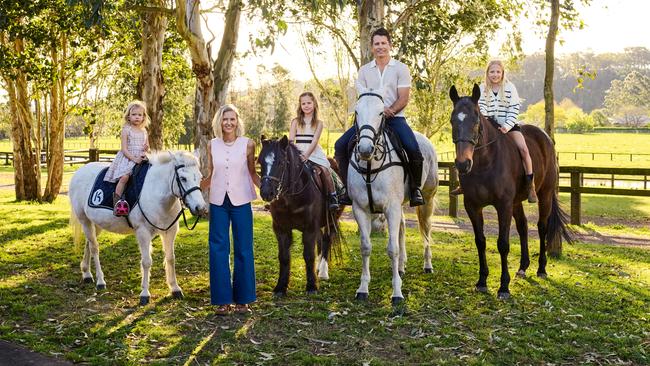
When Elisha Hopkinson starts to feel too busy, it’s likely that, as quickly as is convenient, she will find herself in the vicinity of grass, trees and horses. Ideally all three.
For the chief executive of the APG & Co. group, the fashion collective whose stable includes heritage brands Sportscraft, JAG and Saba, the connection with horses is personal. Her husband is former professional polo player Sam Hopkinson, and her family owns the polo farm in Richmond, NSW where WISH’s shoot took place. It’s also, in a way, a form of meditation.
“I think working in the city and being really busy, I love the opportunity on the weekends to be able to just have soil underneath me and a change of scenery just to keep myself grounded. I’ve got to travel a fair bit for work. And I think [it is] just that slowing down … and having that time with nature to reset and recharge,” she says.
Hopkinson plays polo, too. Just for fun, though, she is at pains to stress.
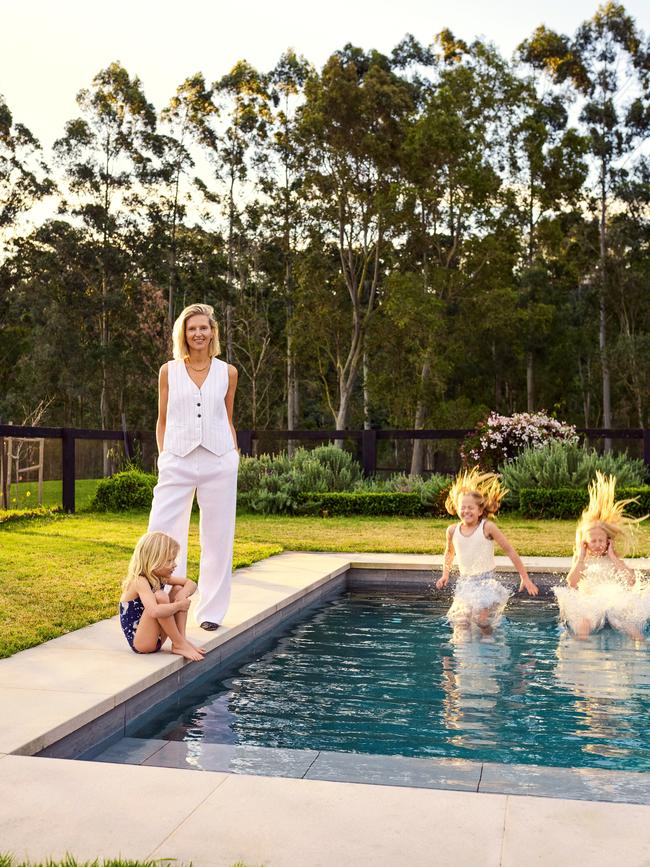
“I played a tournament about four months ago now. I do it probably because it’s accessible and it is great fun, and it’s hard for me. By no means do I want to give you any wrong idea that just because I sit on a horse and try to hit a polo ball that I’m good at it, because it’s extremely hard,” she smiles.
“The one thing that is wonderful about polo is that you’ve got to have so much focus on riding and then you’ve got the ball, you can’t think about anything else.”
Hopkinson’s three daughters, Sienna, 10, Imogen, 8, and Milla, aged 4, all ride horses, Milla on a Shetland pony that is such a bumpy ride, it sometimes puts her to sleep.
Often they spend time at the family farm, where work chat – Hopkinson’s father, John Marshall, is the co-owner and chairman of APG & Co. – is rarely on the agenda. “I’ve been in a family business for so long that it’s a bit of the norm, and obviously it comes with some great things, and it comes with some pain points, like everything. At home, no. I mean, there might be the odd conversation, but there’s kind of like an unsaid rule that we don’t work around the clock,” she says.
“I see [my dad] on some weekends at the polo farm, and my kids do a lot of riding, and so we’ll see them there. But I think, for me – and one of the things that’s probably from when my kids were quite young and I was in the business, and I would be on the phone on the way home and walk in the door – as soon as I’m at home, I have to shift gears into that mother role,” she says.
“Especially because the weeks are heavy and they’re big, and therefore when it is family time, it’s family time.”

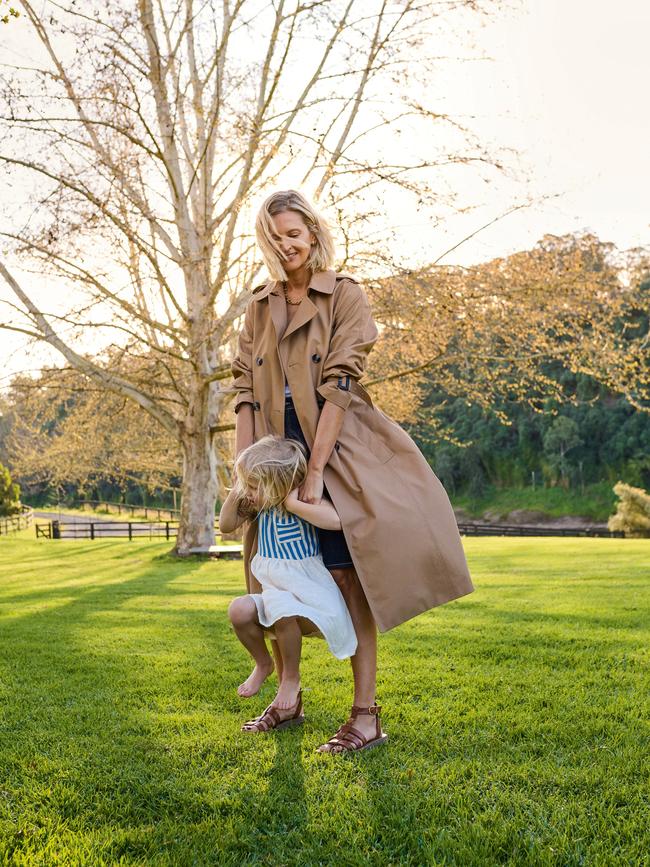
Her husband of 10 years, Sam, owner and executive director of Urban Events, which stages the Urban Polo international event series, doesn’t want to miss out on time with the kids either. “My husband’s kind of like, ‘No, no, no. This is my journey and my life with these kids. I want to be there in the afternoon a day a week to enjoy some of it’. Whereas growing up, I didn’t see my father. He was working the whole time. And I think it’s cool, because life is the journey. It’s not just the destination.”
Hopkinson has spent most of her career in fashion, including three years in New York when she was 25 working for American brands such as Club Monaco, which was then owned by Ralph Lauren. A formative moment was working for Sass & Bide in Sydney in its gloriously exhilarating early days.
“There were 10 people there when I joined, and then by the time I left, there were 50 people and I was responsible for the sales. So I would travel the country and find the boutiques and make sure they had the right brand assortments, and then I would sell the range in. I had such a fun time and the girls are incredibly talented, and Sass
& Bide is one of Australia’s greats,” says Hopkinson of this period.
Something she learned from this time was to think quickly on her feet, and in unconventional ways. “Because it was a small business and growing quickly, you had to be quite entrepreneurial with figuring [things] out as the business grew,” she says.
“Being a part of that journey was very exciting. I was very much out on the road. Sarah Jane [Clarke, co-founder] was shifting into much more of a PR role and therefore I was kind of taking on the selling side of it. I think, for me, I was just so excited to be part of these great girls who were doing these amazing things. I think I was 22 at the time, so it was quite fun.”
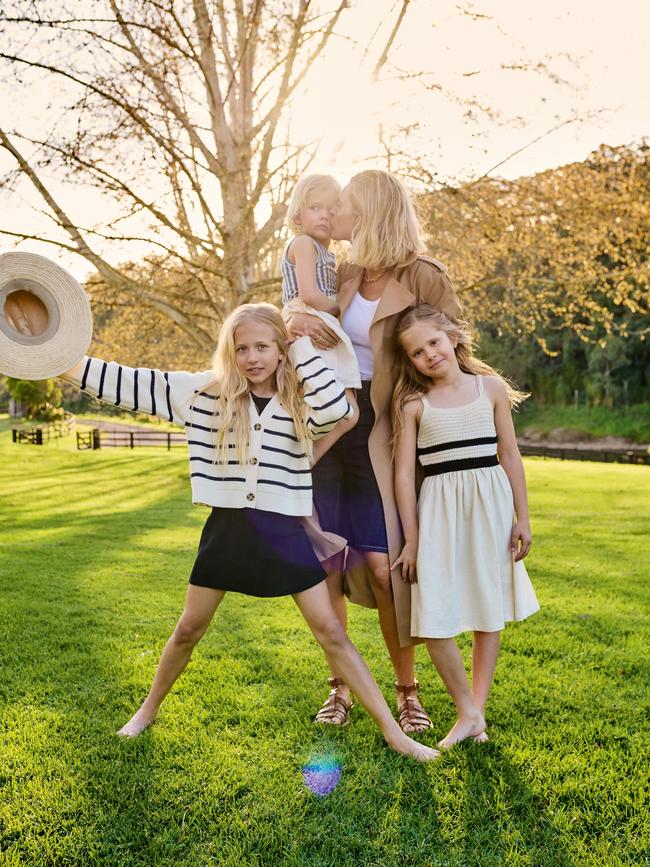
A career in retail however wasn’t especially on the plans, but it got underneath her skin anyway. “My father, when I was young, worked in design and manufacturing, and that’s what our business started out in. I saw him work and thought I never wanted to go into fashion. I went and studied a bachelor’s business degree with a major in marketing and worked for advertising agencies, and then fell into fashion,” she says.
“I think probably when it’s around you, you don’t realise, but you start to pick it up … I think it’s a creative space. Certainly it can be a tough industry, but it’s a real collaborative industry and I really enjoy being able to work with the teams on the creative and collaborative side,” she says. “I think when you’re collaborating, you can achieve so much more than just having one idea.”
This feeling for collaboration is particularly important to Hopkinson right now as she focuses on pushing forward all three of her brands. It’s a big year, in particular, for Sportscraft. The brand celebrates its 110th anniversary, and for the ninth time, outfitted the Australian Olympic athletes for their Paris Games kit.
For Hopkinson, who saw some of the Olympics – the showjumping at Versailles was a highlight – alongside her husband as part of a holiday in July, the Olympics for Sportscraft represents a moment to celebrate Australia’s heritage and sporting prowess.
Hopkinson loves the Games, and sport more broadly, for other reasons, too – including what the athletes represent.
“My viewpoint on the athletes is that, first of all, sport brings us together and it’s a very big part of Australian culture. That seems to be how we unite because we are so diverse in religions and our backgrounds, yet we all love sport. And I think the second thing is that a lot of our Sportscraft customers have young families, and the role models that these athletes are, not only [for] myself and how I want to play with my team in the office, but also for my children and what they see and how they push themselves … I get all emotional talking about it,” she says. “It’s so incredible what they’re achieving and what sport can do for society.”
Sport – much of it deeply reliant on excellent teamwork – is something Hopkinson uses in the office, too.

“I relate a lot of sport back to what we are doing in running a business. Our sport is matching our product to the demands of what our customers want,” she says. “When people are actually more relaxed and in tune with one another, they’re more creative and they’re actually having fun while they’re doing it; they believe they can achieve more. A big part of my role here is making sure that the teams are aligned and that they can contribute to what they think it should be as well.
“We are really just playing a good game of sport together,” she adds with a laugh.
Sportscraft is a brand in which she sees a particular momentum and opportunity. In part, Hopkinson says, it’s because it appeals to people of all ages. Or at least she thinks it should. It’s something she’d like more people to realise.
“Sportscraft’s opportunity is to contemporise the brand ... I’ve done a few workshops recently with my old school friends, many working mums in different fields and also stay-at-home mums, and they have all found something. We as a team at Sportscraft are constantly challenging ourselves as to who is the customer aged 35 to 55,” she says.
“I also think people are much more contemporary in the way that they dress. You can be 65 years of age and you can dress like a 35-year-old woman, you know what I mean? So it’s certainly not about age any longer. It’s very much about a mindset. We are about classic styles, with good quality – and we’ve got some personality.”
It’s also the brand she thinks is particularly well suited to selling the idea of the Australian lifestyle overseas.
Is global expansion on the agenda? One day. All Hopkinson will say is that there are conversations happening, and that she believes the world is looking to Australia for fresh inspiration, and the unique take on living well.
“Australia is so beautiful. And [our] creativity comes from the fact that we are outdoors and we’ve got this land that we can do adventure on, and the climate is so accommodating to be able to do whatever you like,” Hopkinson says.
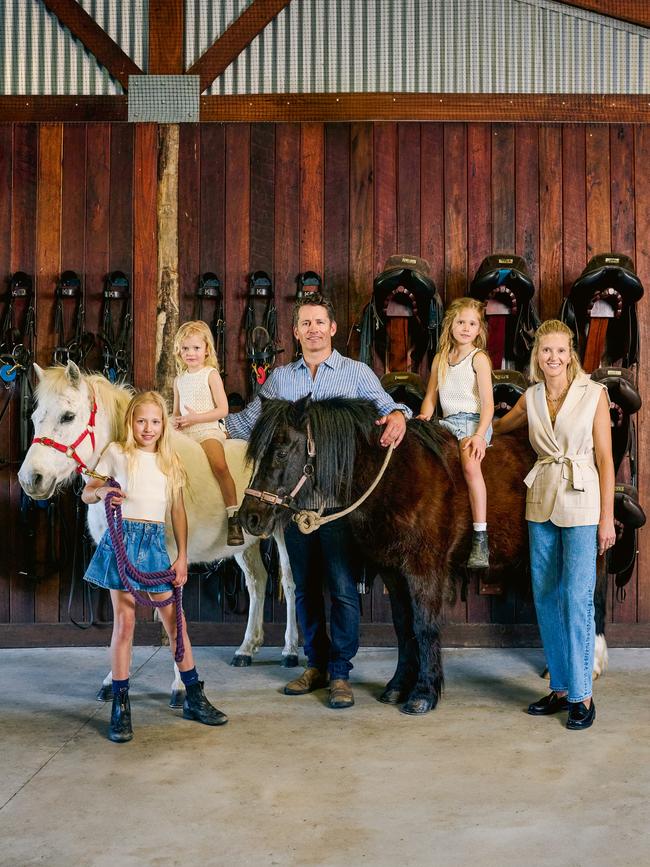
“The Sportscraft brand is so much about embracing the Australian lifestyle and outdoors. We love colour, it’s so important for Australians, and that’s because we’re not always inside … and because we’re outdoors, we’re also more active and sporting-inspired, and that’s very much what Sportscraft is,” she says.
Challenges, as anybody in fashion and retail can attest, abound. For Hopkinson, these include price sensitivities, whether people will actually pay the higher cost for more sustainable materials and manufacturing that they say they will, and the high density of players in a relatively small market.
“We talk a lot about sustainability and we take it seriously in our business. We are investing in a road map towards that and have been for a long time. We’re also a market that [is] spending a lot on these new players that are very inexpensive, and might not have a strong sustainability plan or focus. That’s also a hard thing because [people] say something and then we tend to maybe not purchase so much aligned with that,” she says.
One thing Hopkinson won’t sacrifice, no matter the margin squeeze, is the quality of the materials used.
“We’re going to have to just get better designs and be stronger brands, I won’t ever take out of fabrication or out of the make. We will turn our seam so that they’re actually finished and they’ll less likely split. We all get pressures, but we are really focused on our quality. This business has always had that quality in it, and I need to make sure I don’t ever allow that to be diluted,” she says.

Back to the sporting analogies and for Hopkinson, a fitting analogy of her approach to business is the relay.
“We’ve got these three beautiful Australian heritage brands that had these incredible founders. I’ve got the baton and I’ve got to try to improve it, and then I’ll pass it on,” she says.
And as for those moments of peace found here on the farm; for Hopkinson it’s always a reminder that happiness tends to come in life’s quieter moments.
“I’m at a stage in my life where I’ve got three little people who are on such an exciting journey. I think, probably because life is hectic, I really appreciate being able to have enough time and keep things a bit simpler,” she says.




To join the conversation, please log in. Don't have an account? Register
Join the conversation, you are commenting as Logout